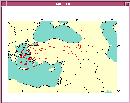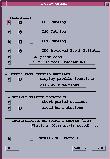

Although some of the geophysical data sets are placed under the images/Grids
menu option, all non-grid type data sets are accessed through this menu
button. Figure 14
shows the content of the "Geophysical Data" menu. The data sets include:
Seismicity catalogs, focal mechanisms, crustal scale refraction and gravity
profile locations and their interpreted depth sections in the Middle East
region, local seismic station locations in the Middle East and North Africa,
broadband station locations in the Middle East and North Africa, International
Monitoring System station locations, and displacement vectors obtained
by GPS in the eastern Mediterranean.
Earthquake Catalogs - ISC, USGS, IDC, CMT
ISC:
International Data Center
USGS:
United States Geological Survey
IDC:
International Data Centre
CMT:
Centroid Moment Tensor of Harvard University
We collected all available and reliable seismic catalogs and placed them into GEOID. These data catalogs include: the USGS, the International Seismological Centre (ISC), Centroid Moment Tensor locations and solutions from Harvard University, and the International Data Centre’s reviewed event bulletins. Among these catalogs, only the ISC’s catalog is global and is complete with all related phase data. The other catalogs include only the locations and primary information such as magnitude, depth, and origin time.
The USGS catalog covers the period from 1964 to 1993. This data set is only for the Middle East and North Africa region. The ISC catalog covers the period from 1964 to 1994. It is global in nature and complete with all the phase information. The CMT catalog is global, and most useful when events with focal mechanisms need to be analyzed. The catalog covers a time period of 1977 and 1996. The magnitudes of the earthquakes in this catalog are 5.5 or higher. All the events are complete with their attributes as provided by the Harvard group. The IDC catalog cover much shorter time period (1996 - Sept, 1997), as the IDC is a new organization. The events are complete with magnitude, depth and origin time information.
 Figure
15 shows earthquakes from the ISC catalog along the Dead Sea fault
system in the Middle East. This map can be obtained by zooming in on the
region using the "Zoom in" button, then checking the ISC catalog check
button in this menu. The events are plotted with varying symbol sizes related
to their magnitudes. Latitude and longitude labels were added
using the "Lat/LOng Grid" tool under the "Map Controls" menu.
Figure
15 shows earthquakes from the ISC catalog along the Dead Sea fault
system in the Middle East. This map can be obtained by zooming in on the
region using the "Zoom in" button, then checking the ISC catalog check
button in this menu. The events are plotted with varying symbol sizes related
to their magnitudes. Latitude and longitude labels were added
using the "Lat/LOng Grid" tool under the "Map Controls" menu.
The "ISC phase data" button can be used to start up new tools for further
analysis and selection of the ISC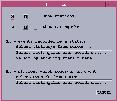 phase data (Figure
16). One can search the ISC data set by either station or event attributes.
In either case, the search can be done for a single station/event or a
group of stations/events located in an area defined by a box. Selecting
a single station can be done either by station name or by simply clicking
on any station on screen. One can also click on an event to select it from
the screen. There are further selection criteria based on date, depth of
events, and azimuths of arrivals. For example, if one decides to select
all events recorded (and reported to the ISC) by station TAB in Iran, he/she
would first click the "select by entering station name" button. This will
initiate a secondary menu shown in Figure
17.
phase data (Figure
16). One can search the ISC data set by either station or event attributes.
In either case, the search can be done for a single station/event or a
group of stations/events located in an area defined by a box. Selecting
a single station can be done either by station name or by simply clicking
on any station on screen. One can also click on an event to select it from
the screen. There are further selection criteria based on date, depth of
events, and azimuths of arrivals. For example, if one decides to select
all events recorded (and reported to the ISC) by station TAB in Iran, he/she
would first click the "select by entering station name" button. This will
initiate a secondary menu shown in Figure
17. 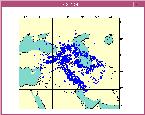 In
this menu, the station name "TAB" is entered in the text input area on
In
this menu, the station name "TAB" is entered in the text input area on 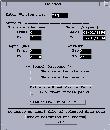 top.
Then any other selection criteria such as event depth, date, distance range
of events, and azimuths can be entered. In this example, if we select a
distance range of 0 to 10 degrees we need to modify the default distance
variables, then click on the "Start search" button. This search will return
all the events in the range of 0– to10 degrees from the station "TAB" between
the years 1964 - 1994. The output on the screen is shown in
top.
Then any other selection criteria such as event depth, date, distance range
of events, and azimuths can be entered. In this example, if we select a
distance range of 0 to 10 degrees we need to modify the default distance
variables, then click on the "Start search" button. This search will return
all the events in the range of 0– to10 degrees from the station "TAB" between
the years 1964 - 1994. The output on the screen is shown in
Figure 18a.
A further step would be either to export the selection as an ascii file
or to view the travel time plots of the selected data. If one would like
to see the travel time data, a click on the "View Travel-Time Curve" button
will initiate a new sub menu 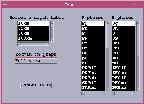
 (Figure
19) and the travel time plot will be displayed on the screen. In this
menu there are options as well. GEOID includes IASPEI-91 travel-time tables.
Certain phases from this travel-time table can be plotted on top of the
observed phase arrivals. First a depth range needs to be selected. The
default value is 10km. This value can be changed by simply clicking on
the appropriate depth value. Then, any desired phase can be selected from
the list in the window. Figure
18b shows the phase readings and theoretical Pn and Sn phase arrivals.
It is also possible to zoom in on a region in the travel-time plot using
the zoom in button.
(Figure
19) and the travel time plot will be displayed on the screen. In this
menu there are options as well. GEOID includes IASPEI-91 travel-time tables.
Certain phases from this travel-time table can be plotted on top of the
observed phase arrivals. First a depth range needs to be selected. The
default value is 10km. This value can be changed by simply clicking on
the appropriate depth value. Then, any desired phase can be selected from
the list in the window. Figure
18b shows the phase readings and theoretical Pn and Sn phase arrivals.
It is also possible to zoom in on a region in the travel-time plot using
the zoom in button.

 Harvard
Centroid Moment Tensor (CMT) solutions are included in GEOID. In order
to display the focal mechanisms, "Plot CMT Focal Mechanisms" button needs
to be clicked (Figure
14). This initiates a new window with several options (Figure
20). In this menu one can select all the events or select a single
event from screen or events located in a region. A linear offset can be
applied to selected event(s) focal mechanisms. Focal mechanisms can be
plotted with varying sizes relative to their magnitudes or they can be
plotted at a fixed size. Once the selection is done, clicking on one of
the checkbuttons at the bottom of the window plots the focal mechanisms.
Figure 21 shows
an example plot showing earthquake locations and a few focal mechanisms
in Eastern Turkey. The focal mechanism data set is global. Hence, a similar
map can be made on any region on earth.
Harvard
Centroid Moment Tensor (CMT) solutions are included in GEOID. In order
to display the focal mechanisms, "Plot CMT Focal Mechanisms" button needs
to be clicked (Figure
14). This initiates a new window with several options (Figure
20). In this menu one can select all the events or select a single
event from screen or events located in a region. A linear offset can be
applied to selected event(s) focal mechanisms. Focal mechanisms can be
plotted with varying sizes relative to their magnitudes or they can be
plotted at a fixed size. Once the selection is done, clicking on one of
the checkbuttons at the bottom of the window plots the focal mechanisms.
Figure 21 shows
an example plot showing earthquake locations and a few focal mechanisms
in Eastern Turkey. The focal mechanism data set is global. Hence, a similar
map can be made on any region on earth.
We have collected from the literature over 60 crustal scale cross sections
in the Middle East region. All profile locations as well 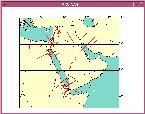 as
their interpretations have been digitized and added into GEOID. Figure
22a shows the locations of these profiles. A similar map can be obtained
by simply checking the data set labeled "Display profile locations" (Figure
14). In order to see the interpreted sections, a new menu is initiated
by clicking on the "Display x-sections" button. This will erase the current
screen and plot a map of the Middle East region with all available profile
locations in the upper left corner of the screen. The remaining area is
used to draw the cross sections (Figure
22b). Up to three profiles can be displayed on the screed at a time.
In order to display one of the profiles, one of the "select profile" buttons
need to be pressed and the desired profile must be selected from the map
on the screen by clicking on the profile. Once a profile is selected, it
will be displayed in the reserved
as
their interpretations have been digitized and added into GEOID. Figure
22a shows the locations of these profiles. A similar map can be obtained
by simply checking the data set labeled "Display profile locations" (Figure
14). In order to see the interpreted sections, a new menu is initiated
by clicking on the "Display x-sections" button. This will erase the current
screen and plot a map of the Middle East region with all available profile
locations in the upper left corner of the screen. The remaining area is
used to draw the cross sections (Figure
22b). Up to three profiles can be displayed on the screed at a time.
In order to display one of the profiles, one of the "select profile" buttons
need to be pressed and the desired profile must be selected from the map
on the screen by clicking on the profile. Once a profile is selected, it
will be displayed in the reserved 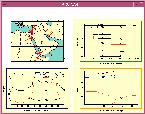 segment
on the screen. The interpreted basement is drawn in red and the Moho is
in blue. These values were used in obtaining the Cornell basement
and Cornell Moho data sets discussed later in this report. The information
about each profile can be downloaded into an ascii file by clicking the
"ascii files" menu button. This opens up a new window. A directory path
and a file name for each profile must be entered. Once the "Done" button
is clicked, an ascii file containing all the information is written. Using
the zoom menu button, any segment of the map or profiles can be zoomed
in, once they are displayed on the screen. In order to create a hardcopy
map of the location map and/or profiles the"hardcopy" button is pressed
and file names are typed. An output format can be selected by choosing
one of three options: Postscript, Illustrator, and CGM.
segment
on the screen. The interpreted basement is drawn in red and the Moho is
in blue. These values were used in obtaining the Cornell basement
and Cornell Moho data sets discussed later in this report. The information
about each profile can be downloaded into an ascii file by clicking the
"ascii files" menu button. This opens up a new window. A directory path
and a file name for each profile must be entered. Once the "Done" button
is clicked, an ascii file containing all the information is written. Using
the zoom menu button, any segment of the map or profiles can be zoomed
in, once they are displayed on the screen. In order to create a hardcopy
map of the location map and/or profiles the"hardcopy" button is pressed
and file names are typed. An output format can be selected by choosing
one of three options: Postscript, Illustrator, and CGM.
In order to view all the profiles and their interpretations you can
also use the
crustal profiles web page.
Data for all broadband stations and for short period stations from some
of the countries of the Middle East were collected and entered into the
GEOID system. The broadband stations are complete with attribute information
such as the operating agency of the station, operation period, and instrument
type. The short period station locations are not complete for the Middle
East and North Africa region. However, the station locations under the
ISC phase data coverage are more complete and can be used to replace these
station locations.

 We
entered all the International Monitoring System (IMS) locations into the
GEOID system. A menu to access these data sets can be initialized by clicking
on the "International Monitoring System" stations menu (Figure
23a). The locations of the stations were taken from the signed Comprehensive
Test Ban Treaty agreement. The stations are divided into four different
categories: Seismic, hydroacoustic, infrasound, and radionuclide. A map
of these stations can be obtained by marking the check mark areas. Using
the "i" button located on top of the window, more information about
each site can be obtained. First clicking on the "i" button and
then on the desired station location would give the stations attributes
in a popup window. Figure
23b shows all the stations.
We
entered all the International Monitoring System (IMS) locations into the
GEOID system. A menu to access these data sets can be initialized by clicking
on the "International Monitoring System" stations menu (Figure
23a). The locations of the stations were taken from the signed Comprehensive
Test Ban Treaty agreement. The stations are divided into four different
categories: Seismic, hydroacoustic, infrasound, and radionuclide. A map
of these stations can be obtained by marking the check mark areas. Using
the "i" button located on top of the window, more information about
each site can be obtained. First clicking on the "i" button and
then on the desired station location would give the stations attributes
in a popup window. Figure
23b shows all the stations.
